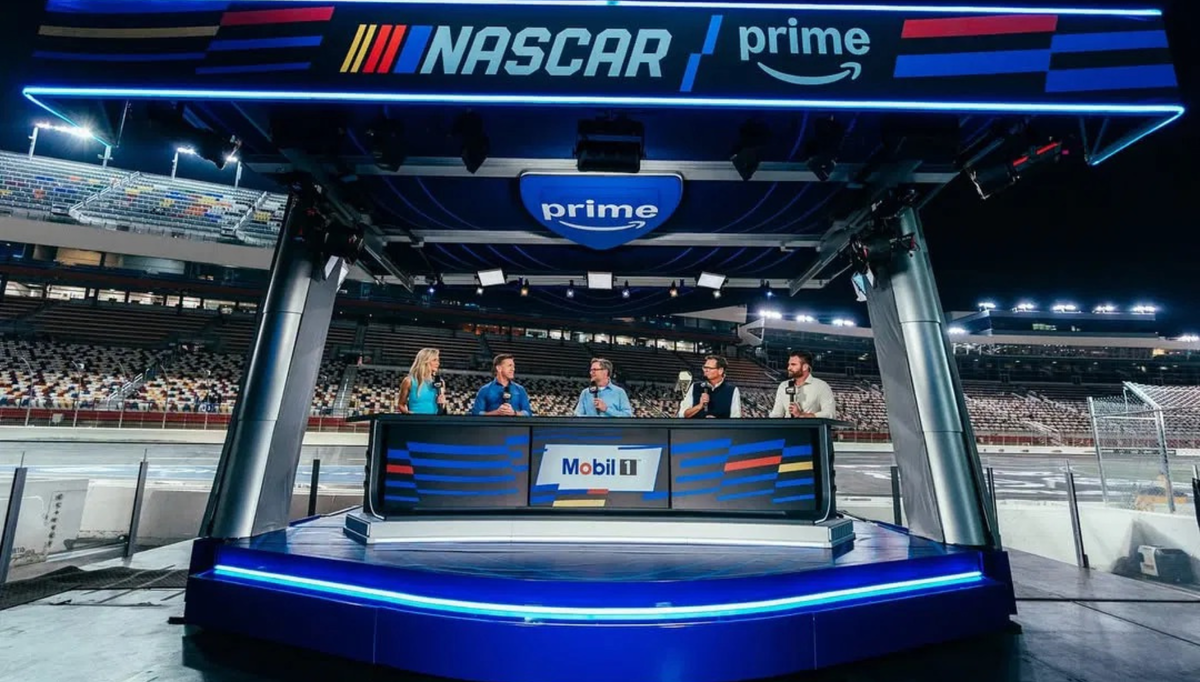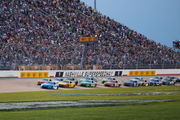

NASCAR on Prime is getting plenty of plaudits lately. Ever since the streaming service took over the Cup Series, fans have been impressed by the quality of the coverage. Tired of FOX’s many blunders and incessant ad breaks, the change appears to be a step in the right direction, even though statistics indicate that the sport is losing some of its older supporters after switching to the platform, with rising costs and accessibility proving to be a major hurdle. However, Amazon Prime’s usage of artificial intelligence is proving to be a real game-changer.
Watch What’s Trending Now!
The streaming service has introduced a ‘burn bar’, allowing users to see the fuel usage of their favorite drivers. This is changing the way stock car racing is consumed, giving fans the kind of insight they have never experienced before.
ADVERTISEMENT
Prime Video is revolutionizing NASCAR streaming
NASCAR teams have been able to measure burn rate and fuel level for years. After all, that’s how race strategy is devised, with every last ounce of gasoline being accounted for. But that sort of technology has never been available to fans until now. With the help of artificial intelligence, Prime Video is using car data, which is freely available to broadcasters and teams, to show the burn bar. The new technology first made an appearance at the Coca-Cola 600 and will also be used at the Viva Mexico 250.
NASCAR on Prime analyst Steve Letarte has contributed to the development of the burn bar. The former crew chief said, as per AP News, “It’s the first true tool that is taking information off the car, making calculations, and then displaying to the fan a calculation or measurement that is being used in the garage. And it does affect the team. There’s not a sensor on the car giving us miles per gallon. It’s a mathematical calculation of other cars performances.”
Last week at Michigan International Speedway, the burn bar faced its first true test as the final 48 laps were raced without a single caution. As most teams made their final pit stop with 50 laps remaining, fuel conservation became key in drivers holding onto their track positions, a lesson William Byron learned the hard way despite dominating the race. Prime Video analyst Sam Schwartzstein said, “We projected William Byron to run out, which he did, and then we were on the razor’s edge for Denny Hamlin.”
ADVERTISEMENT
Denny Hamlin was a few laps ahead on fuel compared to everyone else and battled door-to-door with William Byron to take the lead of the race, with 5 laps remaining. Byron eventually ran out of fuel with one lap to go, as predicted by the burn bar, and had to pit, finishing 28th. This technology is just the start of Prime Video’s plans to revamp the way NASCAR is broadcast.

USA Today via Reuters
Oct 8, 2023; Concord, North Carolina, USA; Cars crowd into turn four after a restart during the Bank of America Roval 400 at Charlotte Motor Speedway Road Course. Mandatory Credit: Jim Dedmon-USA TODAY Sports
With Prime Video having a seven-year agreement to stream five races per season, the company’s senior coordinating producer for live sports, Alex Strand, believes more tools could be implemented in the future. He said, “I think that’s what we’re really excited about is to say, ‘OK, we’ve had success in Year 1 on a feature that’s resonated with fans right out of the gate.’ It raises the table for our offseason.” There’s no doubt that NASCAR’s $2.2 trillion partner has raised the game, and fans are already eager to see what’s in store going forward.
ADVERTISEMENT
Top Stories
Dale Jr. Warns of Deeper Issues as Joe Gibbs Parts Ways With Decade-Long Executive

Chase Elliott’s Popularity Hits New Low as Dale Jr.’s Daytona 500 Return Triggers Record-Breaking Sale

Concerned NASCAR Fans Raise Red Flags Over Safety Issues Ahead of the Daytona 500

NASCAR Faces Uncomfortable Reality as Grassroot Racing Series Rejects Its Formula, Claims Insider

Exclusive: Mark Martin’s Career Philosophy in Both Racing and Life — “Never Lift”

Fans weigh in on Amazon’s new technology
As expected, NASCAR fans couldn’t help but share their thoughts about the new ‘burn rate’ data being provided by Amazon on its streaming platform. With the likes of Dale Earnhardt Jr. and Steve Letarte in the booth, and Adam Alexander serving as race announcer, combined with the data being provided to fans, one Reddit user couldn’t help but say, “Prime coverage is a great way for new viewers to see more than just “cars turning left.”” Another fan praised the use of AI to showcase how the speed of the car influenced fuel usage and wrote, “The burn bar paired with the throttle inputs was really cool.”
ADVERTISEMENT
What makes the burn bar so reliable is that the AI model analyzes thousands of performance data points per second, which includes signals from the in-car telemetry as well as RPMs, throttle, and optical tracking of each car’s position. That’s how it comes to know the fuel consumption and efficiency throughout the race. Not knowing the technology behind the data, one fan said, “How accurate is that thing I wonder.” Speculating on how the burn rate is being provided, one fan guessed, “It’s probably based on SMT data combined with an estimated guess off of the fuel window.”
Impressed by the AI model, one Reddit user gave the burn bar its due credit, comparing it to data that is provided during Formula 1 races. The fan wrote, “It’s funny how the Burn Bar is so much closer to accurate than the F1 Tire Life graphs that were also powered by AWS, which always had one tire at like, 71% wear mere laps after a stop while the others were at 10-15%” For a sport with fans that have shown plenty of resistance to change, it looks like Prime Video’s short stint this season is proving to be a success, especially amongst younger motorsports enthusiasts.
ADVERTISEMENT
ADVERTISEMENT
ADVERTISEMENT
ADVERTISEMENT

